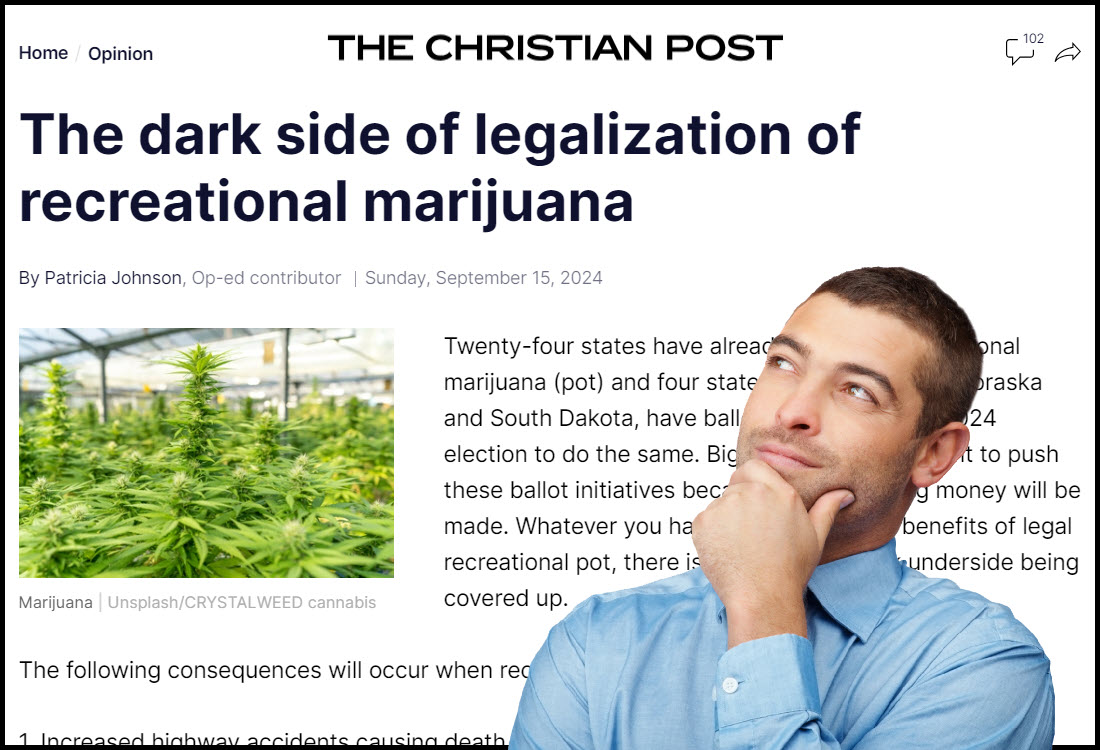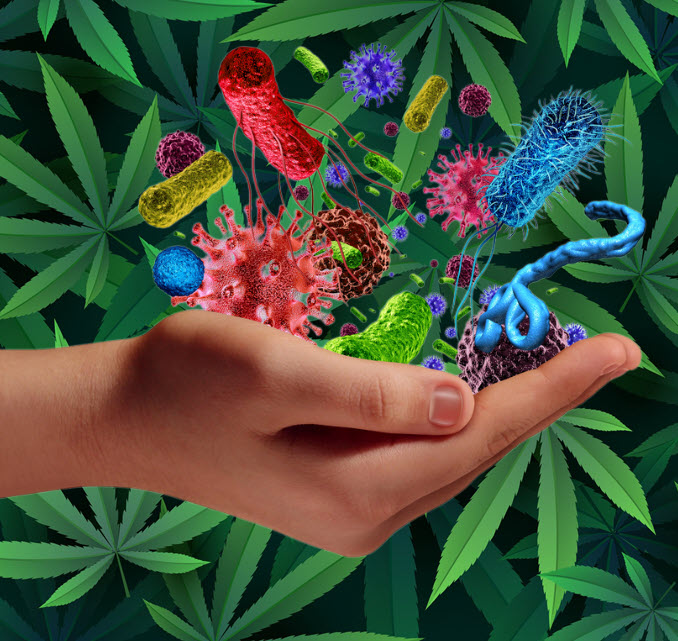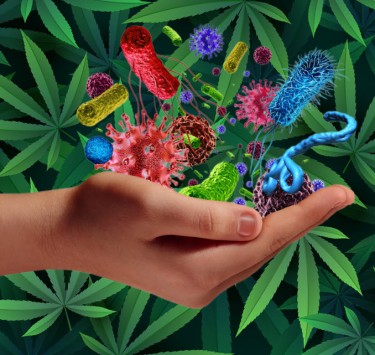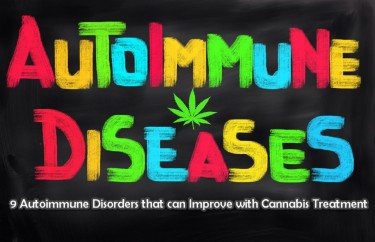Cannabis News
What Do Christian Conservatives Have Against Cannabis?
Published
2 months agoon
By
admin

The green wave continues to sweep across America, folks. This year, we’re set to see even more states embrace the sweet leaf of liberty. But for some, this isn’t cause for celebration – it’s a reason to clutch their pearls and sound the alarm bells.
Now, I’ll be the first to admit that cannabis legalization isn’t all sunshine and rainbows. Like any major policy shift, it comes with its fair share of challenges. But here’s the kicker: those doomsday scenarios that prohibitionists love to paint? They rarely, if ever, come to pass.
In my years of covering cannabis culture and policy, I’ve seen more Reefer Madness redux than I care to count. But I’ve also witnessed the transformative power of legalization – from economic boosts to criminal justice reform. So today, I’m going to lay it all out for you, the good, the bad, and the dank.
I’ve dug up an op-ed from our friends over at the Christian Post. It’s a veritable greatest hits album of anti-cannabis talking points. We’re talking highway carnage, brain-damaged youth, and even Chinese communist pot farms! It’s like they’re playing prohibition bingo, and they’ve got a full card.
But for every point they raise, there’s a counterpoint they conveniently ignore. The hidden benefits of legalization are numerous, from tax revenue that funds schools to reduced racial disparities in arrests. It’s high time we put these arguments side by side and see which ones hold water.
So, strap in, dear readers. We’re about to embark on a journey through the pros and cons of cannabis legalization. My aim? To show you that when we weigh the evidence, the scales tip decisively in favor of legalization. It’s not about creating a perfect world – it’s about crafting better policies based on facts, not fear.
Let’s light this joint and get to it!
Alright, let’s dive into the murky waters of prohibition propaganda and unpack this Christian Post op-ed. Grab your waders, folks – it’s about to get deep.
-
Highway Havoc: Our fearmongers-in-chief kick things off with the classic “stoned drivers will turn our roads into demolition derbies” argument. They cite increased accidents and fatalities in states that have legalized. It’s a concern that plays on our natural fear for safety, especially when it comes to our roads. They’re banking on the image of glassy-eyed potheads weaving through traffic to scare voters.
-
ER Overload: Next up, they’re painting a picture of emergency rooms overflowing with overdosed kids and adults. The specter of children accidentally munching on cannabis edibles is a powerful one. It taps into our protective instincts and makes legalization seem irresponsible. They’re conveniently ignoring the fact that many household items pose similar risks.
-
Crime Wave: Ah, the old “legalization will attract drug lords” chestnut. They argue that the black market will undercut legal prices, leading to more serious crime. It’s a clever twist – admit that petty possession arrests will decrease, but claim violent crime will rise. This plays on fears of community degradation and public safety.
-
Think of the Children: The “brain damage to developing minds” argument is a potent one. It leverages our societal commitment to protecting youth and education. By framing cannabis as a threat to our children’s future, they’re attempting to create a moral imperative against legalization.
-
Farewell, Farms: The claim that cannabis will replace food crops is an interesting one. It taps into anxieties about food security and changing rural landscapes. There’s a hint of nostalgia here – a longing for a simpler, pre-legalization America.
-
Tax Trap: They argue that increased tax revenue will mainly fund new government programs dealing with addiction and safety issues. This is a classic conservative argument against expansion of government services. It’s meant to appeal to small-government advocates.
-
Gateway Ganja: The old gateway drug theory makes an appearance. They’re suggesting that legal cannabis will lead to increased use of harder drugs. This argument has been around since the Reefer Madness days, playing on fears of a slippery slope to harder drug use.
-
Impaired Workforce: There’s mention of employees showing up to work high, tapping into concerns about productivity and workplace safety. It’s an appeal to business owners and those worried about economic impacts.
-
Homelessness Surge: They paint a picture of beautiful cities overrun by homeless drug addicts. This plays on fears of urban decay and social disorder. It’s a powerful image that taps into class anxieties and concerns about community aesthetics.
-
Foreign Influence: The specter of Chinese-funded pot farms is raised, combining drug fears with xenophobia and national security concerns. It’s a clever way to tie cannabis to broader geopolitical anxieties.
-
Youth at Risk: There’s heavy emphasis on how cannabis affects developing brains, citing addiction risks and cognitive impairments. This is perhaps their strongest emotional appeal, leveraging our collective desire to protect the next generation.
-
Globalist Conspiracy: They even throw in a dash of conspiracy theory, suggesting that “globalist elites” want a drugged-up populace that’s easier to control. This appeals to those who distrust big government and international organizations.
-
Misused Tax Dollars: Finally, they argue that cannabis tax revenue doesn’t benefit the general public, but instead goes to managing the problems created by legalization. This is meant to undercut one of the strongest pro-legalization arguments.
Throughout the piece, the authors are painting a dystopian picture of post-legalization America. They’re leveraging every fear and anxiety they can to make cannabis seem like an existential threat to our way of life. It’s a masterclass in prohibitionist propaganda, designed to appeal to conservative values and parental concerns.
But here’s the kicker – most of these arguments fall apart under scrutiny or are based on cherry-picked data. They’re relying on fear rather than facts, emotion rather than evidence. It’s high time we puff, puff, passed on these outdated arguments and looked at the real impacts of legalization.
When we peel back the layers of fear-mongering and look at the cold, hard facts, the benefits of cannabis legalization become as clear as a freshly cleaned bong. Let’s break it down, shall we?
First off, let’s address the elephant in the room – or should I say, the stoned driver behind the wheel? While some studies claim a spike in traffic fatalities post-legalization, they’re missing a crucial element: context. As our friends at NORML pointed out, when you compare legalization states to control states, the picture changes dramatically. In fact, traffic deaths fell by an average of 12% in the three years following legalization in states like California and Massachusetts. Meanwhile, control states saw a 2% increase. It seems the only thing going up in smoke is this particular prohibitionist argument.
Now, let’s talk about who really loses when we legalize – and it ain’t the average Joe. It’s the cartels, baby! In Mexico, the price per kilo of cannabis dropped by a whopping 90% after legalization efforts in the U.S. That’s not just a dent in their profits; it’s a gaping hole. We’re literally stealing money from the bad guys and putting it into legitimate businesses. Speaking of which, employment is up in the cannabis industry. We’re creating jobs, not joint-rolling vagrants.
But wait, there’s more! Opioid deaths are down in states with medical cannabis markets. Big Pharma is losing about $10 billion a year in these states. Forgive me if I don’t shed a tear for the poor pharmaceutical executives who can’t afford a third yacht this year.
Let’s not forget the human cost of prohibition. Fewer people are being jailed for cannabis offenses, saving states millions in incarceration costs. And those who do partake? They’re taking fewer sick days, boosting productivity. They’re also generally slimmer than non-users, with lower BMIs. In a country where obesity-related illnesses cost billions, that’s nothing to sneeze at.
Worried about the kids? Don’t be. There’s a general trend of youth consuming less cannabis in legal states. It turns out, taking away the forbidden fruit appeal makes it less tempting. Who knew?
And let’s talk money, honey. States are generating revenue from something that used to be a total loss. Even if the numbers aren’t sky-high, it’s infinitely better than the net loss from prohibition enforcement and missed tax opportunities.
For medical patients, cannabis is a godsend. From pain management to PTSD treatment, it’s improving lives daily. And let’s not overlook the fundamental issue of bodily autonomy. By legalizing cannabis, we’re giving adults back control over their own bodies and minds.
This is just scratching the surface, folks. The benefits of legalization are as numerous as the strains at your local dispensary. When we weigh the pros and cons, it’s clear that the scales tip heavily in favor of legalization.
It’s high time we embraced a more rational, evidence-based approach to cannabis policy. The war on drugs has been a costly failure. Legalization, on the other hand, is proving to be a win-win situation for public health, safety, and the economy.
So let’s put aside the reefer madness and focus on the reefer gladness. The grass is indeed greener on the legal side!
CONSERVATIVES ON CANNABIS, READ ON…
You may like
-


Dutch police find gnome made of MDMA during drug bust
-


Rejected applicants sue Minnesota over marijuana social equity licensing process
-


4 Ways Marijuana Can Help You Have A Better Thanksgiving
-


Can Big Alcohol Help The Cannabis Industry
-


California Appeals Court Rejects Marijuana Grow Permit, Citing Federal Illegality
-


Expert Lighting Tips For Successful Indoor Growing Weed
Cannabis News
California Appeals Court Rejects Marijuana Grow Permit, Citing Federal Illegality
Published
22 hours agoon
November 22, 2024By
admin
In a landmark decision that highlights the tension between state and federal cannabis laws, a California appellate court ruled on October 29th that property owners can refuse to allow the transportation of cannabis across their land via easements, even when the cannabis operation is approved by local authorities.
The Second District Court of Appeal’s unanimous decision draws attention to private property rights in a context where cannabis remains federally illegal, but state law allows licensed cultivation, distribution and sale. Presiding Justice Albert Gilbert stated, “No matter how much California voters and the Legislature might try, cannabis cultivation and transportation are illegal in California as long as it remains illegal under federal law.” JCCrandall LLC v. County of Santa Barbara, Case No. B333201, 2024 WL 4599304, Oct. 29, 2024.
Unless the California Supreme Court grants review – which I would not rule out – the decision empowers private property owners to refuse to contract with cannabis businesses, and restricts local government from approving cannabis operations that implicate the property rights of neighbors who object.
The case at hand
The dispute centered around a cannabis cultivation operation in Santa Barbara County, where JCCrandall LLC challenged a conditional use permit granted by the County to its neighbor, Santa Rita Holdings Inc. The critical issue was that Santa Rita Holdings could only access its 2.5-acre cannabis farm via an unpaved road crossing JCCrandall’s property through a pre-existing easement. JCCrandall grows oats and barley.
JCCrandall’s primary concern? It raised a number of complaints with the Santa Barbara County Supervisors about truck traffic and night operations, which did not gain traction, but in the Court of Appeal JCCrandall focused on what it claimed was potential liability associated with having federally illegal substances transported across its property, even though County regulators found that the Santa Rita operation was fully compliant with state and local laws.
Key legal findings
The appellate court’s decision hinged on several crucial points:
- Property Rights: The court emphasized that “the right to exclude others is the essence of the right of property ownership” and classified it as a fundamental vested right.
- Federal Supremacy: The panel determined that allowing cannabis transportation across private property “defies the Supremacy Clause” of the U.S. Constitution.
- State vs. Federal Law: While cannabis might be legal under California law, the court ruled that federal law’s prohibition takes precedence in this context.
California cannabis industry implications
Legal experts suggest this ruling could have far-reaching consequences for California’s cannabis industry. Section 1550.5(b) of the California Civil Code makes contracts within California involving cannabis lawful and enforceable, and Santa Rita Holdings bet the ranch on that argument. But the Court of Appeal held that the statute could not compel a landowner to allow cannabis to travel across its property on a pre-existing easement. Licensed operators may find it harder to do business because neighbors who have property rights affected by a cannabis business can object, and, under the JCCrandall ruling, local government must yield to those objections.
An example might be a cannabis dispensary that depends on access to its parking lot via an easement or is located in a shopping center where other lessees have rights to object to tenants notwithstanding the approval of the landlord. In cultivation, many cannabis farms depend on vehicular access through easements because they are remote and do not always have direct access to public thoroughfares, or they depend on water sourced from other properties pursuant to agreements made by prior owners who grew traditional crops. These neighbors might not need to show any negative impact on their property, but can argue that they could be found complicit in federally illegal activities.
I think the most problematic language in the JCCrandall ruling is the following, which might draw the attention of the California Supreme Court and cause it to grant review: “For as long as an easement is enjoyed, its mode and manner of use shall remain substantially the same as it was at the time the easement was created. The County argues the easement was used for agricultural purposes. But there is a vast difference between legal and illegal agricultural purposes.” (Emphasis added.) If California has determined that cannabis cultivation is legal – as it has – and state courts routinely enforce contracts involving cannabis, it is a pretty bold step to declare the use of a lawful pre-existing easement illegal simply because the agricultural crop is cannabis and take away easement access from Santa Rita.
Looking ahead
This decision creates new challenges for cannabis businesses in California, and will result in more disputes among neighbors. While the Biden administration has shown signs of easing federal marijuana restrictions, this ruling demonstrates that the federal-state law conflict continues to create significant legal hurdles for the cannabis industry.
California court decisions also can be persuasive authority in other states, so we might see similar litigation (and decisions) elsewhere in the country where cannabis has been legalized.
The case serves as a reminder that despite California’s progressive stance on cannabis, federal prohibition continues to cast a long shadow over the industry’s operations and development. As the cannabis landscape continues to evolve, this ruling may prompt businesses to reassess their property arrangements and local governments will certainly have to reconsider their permitting processes to give more careful consideration to objections by neighbors who claim that their property rights are implicated by cannabis operations.
Note: This post was first published earlier this month on the Alger ADR Blog.
Cannabis News
Autoimmune Conditions Are Rising Fast in American Medicine, Can Cannabis Help?
Published
2 days agoon
November 21, 2024By
admin

Why Are Autoimmune Conditions On The Rise? And How Cannabis Can Help
Autoimmune diseases refer to a group of medical conditions that occur as a result of the immune system attacking your own tissues.
In a normal human body, the immune system is responsible for protecting the body by producing antibodies that prevent toxins, cancer cells, and viruses from harming the body. However, when one is struck by an autoimmune disorder, the immune system is no longer able to distinguish the difference between dangerous cells and healthy cells. As a result, the healthy cells are attacked, too.
Today, we know of around 100 different kinds of autoimmune conditions. Some of the most common examples of autoimmune conditions include rheumatoid arthritis (RA), lupus, inflammatory bowel disease, celiac disease, Type 1 diabetes, multiple sclerosis (MS), and the Guillain-Barre syndrome (GBS) to name a few. Others include Graves’ disease, Hashimoto’s thyroiditis, psoriasis, and vasculitis.
According to the National Health Council, around 50 million Americans are affected by autoimmune diseases today. This is a conservative estimate, considering that several autoimmune conditions are tricky to treat and so many people go undiagnosed for long periods of time. It’s worrisome to note that there are more people developing autoimmune diseases these days, many of which have reached levels comparable to epidemics.
But cannabis can help!
How Cannabis Can Help Curb And Manage Autoimmune Diseases
Not one single cause is responsible for the alarming growth of autoimmune diseases, though there are several factors at play. While there isn’t just one cause we can point at, it’s certain the reasons lie in our environment. After all, human genetics haven’t changed significantly yet the chemicals, toxins, and pollutants in our food and everyday items have risen dramatically.
In addition, people are getting less sleep than ever; stress rates are through the roof, and people are constantly worried. There is a clear link between psychological stress and physical health as well as immunity, which is why it isn’t unusual – it’s even common – to see many autoimmune disease cases flare up after people experience severe stress caused by grief, an accident, job loss, or the death of a loved one. These highly stressful and traumatic conditions wreak havoc on the body’s immune response, causing inflammation all over the body.
Conventional treatments prescribed to treat autoimmune conditions are focused on taming inflammation; these usually include steroids but also some non-steroidal drugs. These drugs often come with unwanted side effects, but research has shown that cannabis can work with the endocannabinoid system through THC and CBD, as well as other cannabinoids, to simulate similar results. In one study for example, we can see the clear association of the endocannabinoid system for neurodegenerative and inflammatory processes seen in Multiple Sclerosis and Amyotrophic Lateral Sclerosis.
There has also been an increasing number of studies proving the efficacy of cannabis for treating several autoimmune conditions.
Cannabis For Multiple Sclerosis
Multiple sclerosis is one of the autoimmune conditions where a growing number of studies have come out supporting the therapeutic benefits of cannabis for. In a 2024 study, patients with multiple sclerosis reported several improvements in quality of life after using cannabis-based medical products (CBMPs). For the study, British investigators analyzed the impact of cannabis based medicinal products made from either oil or extracts in 141 patients who were enrolled in the UK Medical Cannabis Registry.
The researchers then analyzed the changes in patient outcomes after a month, then three and 6 months after. According to the patients themselves, they were able to sustain improvements in their mental and physical health after marijuana therapy.
“This case series demonstrates a potential association between the initiation of CBMPs and improved patient reported outcomes in sleep, anxiety, and general HRQoL [health-related quality of life] measures, over six months,” said the study authors. “Additional measures for HRQoL, including various physical and mental health subdomains, also exhibit improvements up to six months when compared to baseline,” the authors concluded.
In another study from 2023, patients with multiple sclerosis reported significant improvements in symptoms after cannabis use. For the study, researchers from the Dent Neurologic Institute in Buffalo, New York, analyzed the medical records of 141 patients with multiple sclerosis, who were also legally authorized to consume medical marijuana products. They then analyzed data from the patients after one up to 4 follow-up sessions after the initial session of cannabis therapy. Sixty-five percent of patients consumed 1:1 THC:CBD tinctures.
According to the authors: “The results of this study indicate that use of MC [medical cannabis] to alleviate symptoms of MS is largely efficacious, with improvement in pain (72 percent of patients), muscle spasticity (48 percent of patients), and sleep disturbance (40 percent of patients) frequently reported.”
“More than half of opioid users at baseline were able to either discontinue or decrease their opioid use after starting MC. The mean daily MME [morphine milligram equivalents] was significantly reduced from the initial visit (51 mg) to the last follow-up visit (40 mg). This is consistent with previous literature showing that MC legalization is associated with decreased opioid use and that MC use is associated with decreased opioid use in patients with chronic pain. These findings indicate that MC may represent an alternative analgesic to opioids for some patients,” they wrote.
Anecdotal Evidence
While more studies are needed to determine cannabis’ effect on other autoimmune conditions such as rheumatoid arthritis, we can rely on anecdotal evidence. In 2020, data from the medical journal, Rheumatology, revealed that patients who have this condition, along with those who have lupus and fibromyalgia, consume cannabis.
In fact, it was reported that marijuana was extremely common especially for patients with fibromyalgia. “In this meta-analysis, we found that one in six patients suffering from rheumatologic disease actively consumes cannabis, reducing pain reduction… A favorable effect of cannabis on pain in our meta-analysis reinforces the idea that cannabis could be used for analgesic purposes,” the authors concluded.
Conclusion
Cannabis is a safe and natural way to help prevent and treat the symptoms of autoimmune disease. It targets inflammation at its root, and is a proven natural way to help cope with stress, pain, insomnia, and inflammation all while protecting the brain. However, it’s important to ensure you medicate with clean, organic sources of marijuana.
AUTOIMMUNE AND CANNABIS, READ ON…

The U.S. Senate’s version of the Farm Bill finally landed this week. They’re calling it the Rural Prosperity and Food Security Act of 2024 (the “Senate bill”). The Senate bill follows on the House’s proposal, called the Farm, Food and National Security Act of 2024 (the “House bill”), offered in May. Neither the Senate bill nor the House bill would preempt state or Indian law regarding hemp or the regulation of hemp products. This means states and tribes will retain a lot of latitude in regulating hemp and hemp-derived products– which gets people fired up.
Aside from giving states some runway, the Senate bill and the House bill differ in key respects regarding hemp. Therefore, these august bodies must confer and reconcile their sundry proposals. That could happen in 2024, but seems more likely in 2025 when the new Congress convenes. As of this week, though, we finally have a framework.
The Senate Bill re-defines “hemp” and defines “industrial hemp”
Section 10016 of the Senate bill (“Hemp Production”) amends the definition of “hemp.” Hemp was defined in the 2018 Farm Bill and removed from the federal Controlled Substances Act (CSA), taking us on a truly wild ride. See: What Happened to Hemp? (“What Happened”). The Senate bill also gives us a definition for “industrial hemp.” Here are those definitions, with points of emphasis in bold:
(1) Hemp. The term “hemp” means (A) the plant Cannabis sativa L. and any part of that plant, including the seeds thereof and all derivatives, extracts, cannabinoids, isomers, acids, salts, and salts of isomers, whether growing or not, with a delta-9 total tetrahydrocannabinol concentration (including tetrahydrocannabinolic acid) of not more than 0.3 percent on a dry weight basis; and (B) industrial hemp.
(3) Industrial Hemp. The term “industrial hemp” means the plant Cannabis sativa L. if the harvested material (A) is only (i) the stalks of that plant, fiber produced from those stalks, or any other manufactured product, derivative, mixture, or preparation of those stalks (except cannabinoid resin extracted from those stalks); (ii) whole grain, oil, cake, nut, hull, or any other compound, manufactured product, derivative, mixture, or preparation of the seeds of that plant (except cannabinoid resin extracted from the seeds of that plant); or (iii) viable seeds of that plant produced solely for production or manufacture of any material described in clause (i) or (ii); and (B) will not be used in the manufacturing or synthesis of natural or synthetic cannabinoid products.
The new regime
Again, the definitional stuff in bold is what I want to emphasize.
First, the Senate bill keeps the THC threshold at 0.3 percent, which is an arbitrary number we’ve been advocating against for years. The Senate bill mirrors the House bill in this respect, though, so we are stuck with this, unless Ron Paul gets his way.
Second, the Senate bill keeps the 2018 Farm Bill’s total THC standard, including THCA. The House bill does this too. This was fairly predictable: in What Happened, I wrote that we could “expect the total THC standard to remain, which means that actual Delta-9 THC won’t be the only metric for calculating THC content.”
We’ve also explained on this blog that the 2018 Farm Bill and USDA rules mandate total THC testing on pre-harvest hemp batches, but do not mandate such testing on post-harvest hemp or hemp products. The Senate bill doesn’t change this paradigm, which means the “loophole” for gas station weed remains open. This proposal is a big win for opponents of the House bill’s “Miller Amendment,” which would narrow the definition of “hemp” to exclude intoxicating hemp-derived substances.
Third, the Senate bill introduces a new definition and framework for industrial hemp. The House bill does this too, albeit slightly differently. The idea here is to invite farmers to grow hemp for fiber and grain purposes, while freeing them from regulatory burdens with the Department of Agriculture and criminal exposure with the Department of Justice. More specifically, for “industrial hemp” growers, the Senate bill:
- removes background check requirements;
- instates “relaxed regulatory requirements” for sampling and inspection methodologies (which will need to be adopted by rule); and
- develops a certified seed program.
The Senate bill also makes any hemp producer ineligible to grow hemp for five years if that producer, “with a culpable mental state greater than negligence, produces a crop of hemp that is inconsistent with that license.”(Hint: use the seed program.) The proof standard here seems like it could be an issue, and even if anyone has been adjudicated as growing marijuana under the guise of hemp, Farm Bill ineligibility seems like a far-off concern.
Bottom line
The big takeaway for me is that the Senate bill leaves the door open for intoxicating hemp products, whereas the Miller Amendment to the House bill does not. Something’s gotta give. And it needs to happen soon, because we’re already long overdue. As I explained in a webinar last week, the Farm Bill deals with the nation’s entire food supply, not just hemp. Therefore, this is not like with the SAFE Banking Act, where we have a proposed law specific to cannabis that may or may not ever pass. The Farm Bill must pass, and soon.
Stay tuned and we’ll keep you updated on any major happenings. For more on this topic, check out our massive hemp and CBD archive, or these specific, recent posts:

Dutch police find gnome made of MDMA during drug bust

Rejected applicants sue Minnesota over marijuana social equity licensing process

4 Ways Marijuana Can Help You Have A Better Thanksgiving

Can Big Alcohol Help The Cannabis Industry

California Appeals Court Rejects Marijuana Grow Permit, Citing Federal Illegality

Expert Lighting Tips For Successful Indoor Growing Weed

Acne And CBD: Exploring Alternative Dermatological Solutions

Can I Gift Marijuana This Holiday Season?

The Best Cocktails For An Easy Festive Thanksgiving

420 Vacations: Planning the Perfect Weed Vacation

Distressed Cannabis Business Takeaways – Canna Law Blog™

United States: Alex Malyshev And Melinda Fellner Discuss The Intersection Of Tax And Cannabis In New Video Series – Part VI: Licensing (Video)

What you Need to Know

Drug Testing for Marijuana – The Joint Blog

NCIA Write About Their Equity Scholarship Program

It has been a wild news week – here’s how CBD and weed can help you relax

Cannabis, alcohol firm SNDL loses CA$372.4 million in 2022

A new April 20 cannabis contest includes a $40,000 purse

Your Go-To Source for Cannabis Logos and Designs

UArizona launches online cannabis compliance online course
Trending
-

 Cannabis News2 years ago
Cannabis News2 years agoDistressed Cannabis Business Takeaways – Canna Law Blog™
-

 One-Hit Wonders2 years ago
One-Hit Wonders2 years agoUnited States: Alex Malyshev And Melinda Fellner Discuss The Intersection Of Tax And Cannabis In New Video Series – Part VI: Licensing (Video)
-

 Cannabis 1012 years ago
Cannabis 1012 years agoWhat you Need to Know
-

 drug testing11 months ago
drug testing11 months agoDrug Testing for Marijuana – The Joint Blog
-

 Education2 years ago
Education2 years agoNCIA Write About Their Equity Scholarship Program
-

 Cannabis2 years ago
Cannabis2 years agoIt has been a wild news week – here’s how CBD and weed can help you relax
-

 Marijuana Business Daily2 years ago
Marijuana Business Daily2 years agoCannabis, alcohol firm SNDL loses CA$372.4 million in 2022
-

 California2 years ago
California2 years agoA new April 20 cannabis contest includes a $40,000 purse





